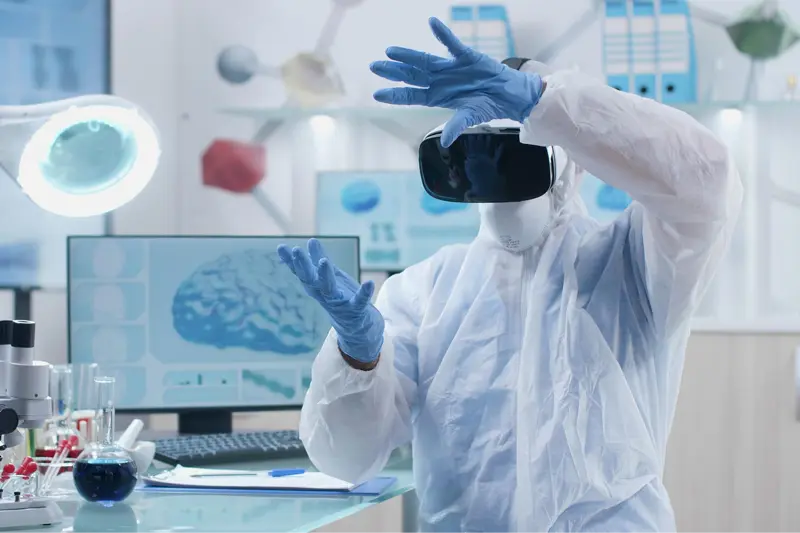
Table of Contents
Smart technology is transforming many fields and healthcare is no exception. Advanced technologies from wearable devices that monitor vital signs to AI-driven diagnostic tools are reshaping healthcare delivery. One area where this innovation is making a significant impact is medical transcription. Smart technology has reduced the time and effort needed to convert physician dictated reports into written text for patient records. Medical transcription services provided by humans support these innovations by ensuring that machine-generated reports are accurate and complete.
Here are the main technological developments that are transforming the healthcare workplace:
- Electronic Health Records (EHRs): Paper-based medical records have given way to EHRs. EHRs have made patient care more efficient, accurate, and patient-centered. These standardized systems offer a secure repository for patient records and make them easily accessible to authorized users. EHRs ensure accurate and up-to-date information, reducing risk of errors and improving patient safety. They also drive collaboration among healthcare providers, improving care delivery.
- Data Analytics: In today’s healthcare landscape, data is king. Advanced analytics tools empower healthcare organizations to harness the full potential of their data. By analyzing this information, they can identify trends, optimize resource allocation, and improve patient care delivery. Predictive analytics, in particular, can pinpoint patients at risk of developing certain conditions, facilitating early intervention and preventive care.
- Artificial Intelligence (AI) and Machine Learning (ML): These powerful technologies are revolutionizing healthcare workplaces by enhancing efficiency, accuracy, and patient outcomes. AI and ML are being utilized to analyze vast amounts of medical data, helping healthcare providers make more informed decisions. In diagnostics, these technologies can identify patterns and anomalies in imaging and lab results, often with greater speed and accuracy than human interpretation. AI and ML are also optimizing administrative tasks, such as scheduling, billing, and resource management, freeing up healthcare professionals to focus more on patient care.
Telehealth and Telemedicine
Telemedicine and telehealth systems allow physicians to deliver medical services remotely. They are becoming integral components of modern healthcare workplaces, facilitating real-time consultations and supporting remote monitoring and chronic disease management with timely follow-ups, without the need for in-person visits. Telehealth bridges the gap between healthcare providers and patients, especially in in underserved or geographically isolated areas. They also allow healthcare providers in different locations to collaborate, thus improving the quality of care.
Smart technology has also improved the efficiency of medical transcription. Let’s see how.
How Smart Technology Enhances Medical Transcription
Traditionally, medical transcription, the process of converting voice-recorded physician reports into written text, was done by dedicated human transcriptionists.
Smart technology has transformed the transcription process in several ways:
- Voice Recognition Software: Advanced AI-powered voice recognition software can accurately transcribe spoken words into text, reducing the time and effort required to do it manually. This technology not only speeds up the transcription process but also enables real-time documentation during patient visits. Physicians just need to dictate and the tool will automatically capture and convert the voice recordings into text. This technology learns from previous data, continually improving its accuracy over time.
- AI-Powered Error Detection: Smart transcription systems are now equipped with AI algorithms that can detect and correct errors in real-time. For e.g., medication errors, such as incorrect dosages or wrong medications, can have serious consequences for patients. AI systems can analyze patient data, medication orders, and clinical guidelines to identify such errors before they happen. This improves patient safety as well as the accuracy of medical records, ensuring that healthcare providers have reliable information to base their decisions on.
- Natural Language Processing (NLP): NLP algorithms can understand context and medical terminology, enabling the software to interpret complex phrases correctly. This results in fewer errors and a more reliable transcription process.
- Integration with Electronic Health Records (EHRs): Smart technology enables seamless integration of transcribed documents into EHR systems. This means that transcriptions can be automatically uploaded and organized within a patient’s digital records, making it easier for healthcare providers to access and update patient information.
- Remote Transcription Services: Cloud-based medical transcription dictation software allows clinicians to dictate notes any time, regardless of location or device. Transcriptionists can access the data, work from anywhere and provide transcriptions 24/7, which is especially useful in emergency or high-demand situations. The software also comes with advanced security protocols to protect sensitive information.
Benefits of Smart Technology in Medical Transcription
- Increased Accuracy: AI-driven error detection and correction improves, medical transcription accuracy, reducing the risk of errors in patient records.
- Enhanced Efficiency: Enables faster transcription turnaround times, allowing physicians to focus more on patient care.
- Cost-Effective Solutions: Can lower operational costs required for manual transcription
- Improved Patient Care: Ensures that healthcare providers have up-to-date information, leading to better patient outcomes.

Smart technology is reshaping healthcare, particularly in the field of medical transcription. Future advancements may include even more sophisticated AI that can understand complex medical terminology, contextual aspects, and potentially handle transcription with minimal human intervention. Embracing these innovations is crucial for the future of healthcare, ensuring that providers can deliver the best possible care in an increasingly complex environment.
However, even while technology enhances the transcription process, the role of skilled transcriptionists will remain vital. Their expertise is essential in ensuring that transcriptions are not only accurate but also contextual and complete.


